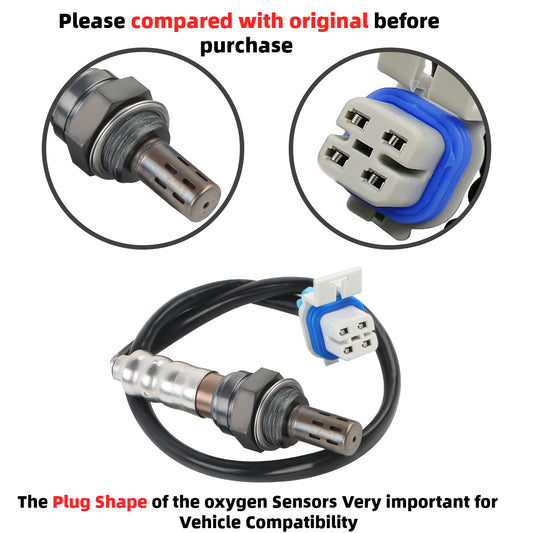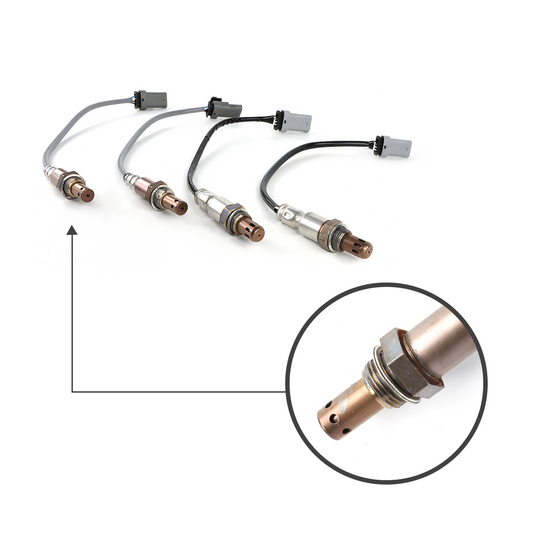What Are The Symptoms Of A Bad Oxygen Sensor?
Since Germany's Bosch and Japan's Toyota first applied oxygen sensors to automobiles in 1976 and serialized their products, in just over a decade, automotive oxygen sensors have been widely used in Japan, the United States, and Europe to control the air-fuel ratio and purify exhaust gases, with a total of hundreds of millions of vehicles.
The function of the oxygen sensor is to monitor the oxygen content in the engine exhaust, and output signal voltage according to the measured data, which is fed back to the ECU to control the amount of fuel injection so that the car engine is in the best combustion state at all times. When used in conjunction with a three-way catalytic converter, it can reduce harmful components in automobile exhaust by more than 80%, saving 5% to 20% of fuel. It is a necessary means of energy conservation and emission reduction and is therefore valued by countries around the world.

Symptoms of a Failing Oxygen Sensor
Oxygen sensors are not components that need regular servicing or replacement like brake pads or motor oil. They typically last anywhere between 30,000 to 100,000 miles and should be replaced as soon as they fail. When your oxygen sensor goes bad, it’s only a matter of time before you start experiencing some of the symptoms below:
1. Check Engine Light
Illumination: The most common symptom is the illumination of the check engine light on the dashboard. The vehicle's onboard diagnostics system detects abnormal readings from the oxygen sensors and triggers this warning light.
2. Poor Fuel Economy
Increased Fuel Consumption: A bad oxygen sensor can cause the engine control unit (ECU) to miscalculate the air-fuel mixture, often leading to a richer mixture (too much fuel). This results in increased fuel consumption and reduced fuel efficiency.
3. Engine Performance Issues
Rough Idling: The engine may idle roughly or stall due to an incorrect air-fuel mixture.
Hesitation and Stumbling: The vehicle may hesitate or stumble during acceleration, especially from a stop or at low speeds.
Lack of Power: A noticeable decrease in engine power and responsiveness.
4. Emission Test Failure
High Emissions: A malfunctioning oxygen sensor can cause the vehicle to emit higher levels of pollutants, leading to a failed emissions test.
5. Black Smoke from Exhaust
Rich Fuel Mixture: Excessive fuel in the combustion process can cause black smoke to be emitted from the exhaust.
6. Rotten Egg Smell
Sulfur Smell: A rich fuel mixture can cause unburned fuel to enter the catalytic converter, which may produce a rotten egg (sulfur) smell as it reacts with the catalyst.
7. Catalytic Converter Damage
Overheating: A faulty oxygen sensor can lead to improper combustion, causing the catalytic converter to overheat and potentially become damaged. This can result in more severe engine problems and costly repairs.
8. Increased Engine Wear
Contaminants: An incorrect air-fuel mixture can lead to the buildup of contaminants in the engine, which can cause increased wear and tear on engine components over time.
9. Drivability Issues
Surging and Bucking: The vehicle may experience surging or bucking, particularly at cruising speeds, due to erratic air-fuel mixture adjustments.
Diagnosing a Bad Oxygen Sensor
OBD-II Scanner: Use an OBD-II scanner to read the diagnostic trouble codes (DTCs) stored in the vehicle’s ECU. Common codes related to oxygen sensors include P0130 to P0161.
Visual Inspection: Inspect the oxygen sensor and its wiring for signs of damage, corrosion, or disconnection.
Voltage Test: Measure the voltage output of the oxygen sensor using a multimeter to check if it is within the expected range.

Do You Know Oxygen sensor poisoning?
Oxygen sensor poisoning refers to the contamination of the oxygen sensor's sensing element, which can impair its ability to accurately measure the oxygen levels in the exhaust gases. This contamination can result from various substances that come into contact with the sensor. Here are the key aspects of oxygen sensor poisoning:
- Silicone Contamination
![]()
(New O2 sensor (left) and fouled O2 sensors (middle and right). Silicon dioxide forms a whitish deposit similar to the middle sensor.)
Source: Silicone-based products such as certain gasket sealants, engine lubricants, and antifreeze.
Effect: Silicone can create a glass-like coating on the sensor, inhibiting its ability to detect oxygen accurately.
- Lead Poisoning

Source: Leaded gasoline (rare in modern vehicles but still possible in certain regions or with specific fuel additives).
Effect: Lead deposits can form on the sensor, significantly reducing its efficiency and lifespan.
- Fuel Contaminants

Source: Low-quality or contaminated fuel containing sulfur, phosphorus, or other additives.
Effect: These contaminants can coat the sensor, interfering with its function.
- Oil and Coolant Leaks

Source: Engine oil or coolant leaks that allow these fluids to enter the combustion chamber and be expelled into the exhaust system.
Effect: Oil and coolant residues can foul the sensor, reducing its effectiveness.
Preventing Oxygen Sensor Poisoning
- Use High-Quality Fuel: Opt for reputable fuel brands that ensure low levels of contaminants.
- Avoid Silicone-Based Products: When performing engine repairs, use non-silicone-based gasket sealants and lubricants.
- Regular Maintenance: Ensure regular vehicle maintenance to prevent oil and coolant leaks that can contaminate the exhaust system.
- Monitor Additives: Be cautious with fuel additives and ensure they are safe for oxygen sensors.
Cleaning or Replacing a Poisoned Oxygen Sensor
In some cases, lightly contaminated sensors can be cleaned using specialized oxygen sensor cleaners. However, this is not always effective and is not recommended as a long-term solution. If the sensor is heavily contaminated or damaged, it is best to replace it. Ensure the new sensor is compatible with your vehicle's make and model.
Oxygen sensor poisoning is a significant issue that can affect the performance, efficiency, and emissions of a vehicle. Understanding the causes and symptoms can help in diagnosing and addressing the problem promptly. Preventive measures, such as using high-quality fuel and avoiding certain contaminants, can prolong the lifespan of oxygen sensors and maintain optimal vehicle performance.
Replacing a Bad Oxygen Sensor
If an oxygen sensor is diagnosed as faulty or poisoned, it must be replaced promptly to restore proper engine function and emissions control. Modern vehicles may have more than one oxygen sensor, so be sure to identify and replace the correct one. Regular maintenance and the use of high-quality fuel can help prevent oxygen sensor problems.
Choose a high-quality sensor from a reputable manufacturer to ensure accurate readings and longevity. As an online store, Daysyore is dedicated to providing high-quality aftermarket auto parts. we are delighted to provide you with the required auto parts products.

















